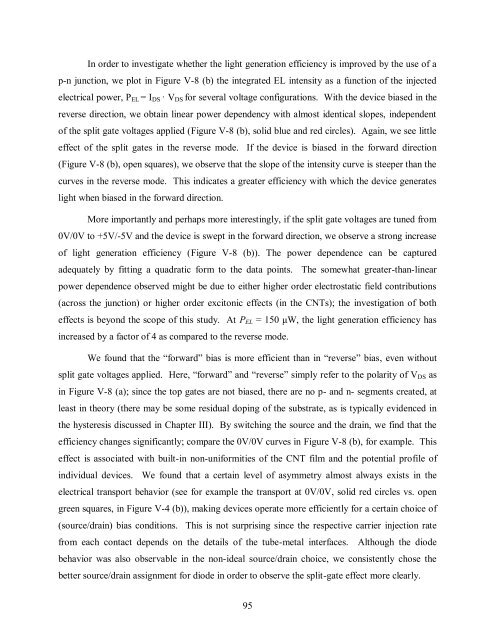Optoelectronics with Carbon Nanotubes
Optoelectronics with Carbon Nanotubes
Optoelectronics with Carbon Nanotubes
Create successful ePaper yourself
Turn your PDF publications into a flip-book with our unique Google optimized e-Paper software.
In order to investigate whether the light generation efficiency is improved by the use of a<br />
p-n junction, we plot in Figure V-8 (b) the integrated EL intensity as a function of the injected<br />
electrical power, PEL = IDS · VDS for several voltage configurations. With the device biased in the<br />
reverse direction, we obtain linear power dependency <strong>with</strong> almost identical slopes, independent<br />
of the split gate voltages applied (Figure V-8 (b), solid blue and red circles). Again, we see little<br />
effect of the split gates in the reverse mode. If the device is biased in the forward direction<br />
(Figure V-8 (b), open squares), we observe that the slope of the intensity curve is steeper than the<br />
curves in the reverse mode. This indicates a greater efficiency <strong>with</strong> which the device generates<br />
light when biased in the forward direction.<br />
More importantly and perhaps more interestingly, if the split gate voltages are tuned from<br />
0V/0V to +5V/-5V and the device is swept in the forward direction, we observe a strong increase<br />
of light generation efficiency (Figure V-8 (b)). The power dependence can be captured<br />
adequately by fitting a quadratic form to the data points. The somewhat greater-than-linear<br />
power dependence observed might be due to either higher order electrostatic field contributions<br />
(across the junction) or higher order excitonic effects (in the CNTs); the investigation of both<br />
effects is beyond the scope of this study. At PEL = 150 μW, the light generation efficiency has<br />
increased by a factor of 4 as compared to the reverse mode.<br />
We found that the “forward” bias is more efficient than in “reverse” bias, even <strong>with</strong>out<br />
split gate voltages applied. Here, “forward” and “reverse” simply refer to the polarity of VDS as<br />
in Figure V-8 (a); since the top gates are not biased, there are no p- and n- segments created, at<br />
least in theory (there may be some residual doping of the substrate, as is typically evidenced in<br />
the hysteresis discussed in Chapter III). By switching the source and the drain, we find that the<br />
efficiency changes significantly; compare the 0V/0V curves in Figure V-8 (b), for example. This<br />
effect is associated <strong>with</strong> built-in non-uniformities of the CNT film and the potential profile of<br />
individual devices. We found that a certain level of asymmetry almost always exists in the<br />
electrical transport behavior (see for example the transport at 0V/0V, solid red circles vs. open<br />
green squares, in Figure V-4 (b)), making devices operate more efficiently for a certain choice of<br />
(source/drain) bias conditions. This is not surprising since the respective carrier injection rate<br />
from each contact depends on the details of the tube-metal interfaces. Although the diode<br />
behavior was also observable in the non-ideal source/drain choice, we consistently chose the<br />
better source/drain assignment for diode in order to observe the split-gate effect more clearly.<br />
95
















